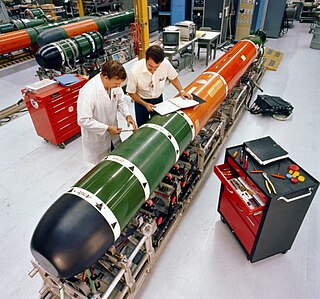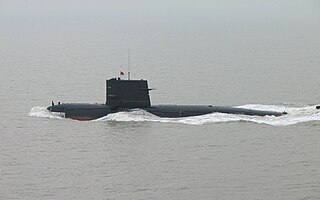Related Research Articles

K-141 Kursk was an Oscar II-class nuclear-powered cruise missile submarine of the Russian Navy. On 12 August 2000, K-141 Kursk was lost when it sank in the Barents Sea, killing all 118 personnel on board.

A modern torpedo is an underwater ranged weapon launched above or below the water surface, self-propelled towards a target, and with an explosive warhead designed to detonate either on contact with or in proximity to the target. Historically, such a device was called an automotive, automobile, locomotive, or fish torpedo; colloquially a fish. The term torpedo originally applied to a variety of devices, most of which would today be called mines. From about 1900, torpedo has been used strictly to designate a self-propelled underwater explosive device.

A depth charge is an anti-submarine warfare (ASW) weapon designed to destroy submarines by detonating in the water near the target and subjecting it to a destructive hydraulic shock. Most depth charges use high explosives with a fuze set to detonate the charge, typically at a specific depth from the surface. Depth charges can be dropped by ships, patrol aircraft and helicopters.

A midget submarine is any submarine under 150 tons, typically operated by a crew of one or two but sometimes up to six or nine, with little or no on-board living accommodation. They normally work with mother ships, from which they are launched and recovered and which provide living accommodation for the crew and support staff.

The Mark 48 and its improved Advanced Capability (ADCAP) variant are American heavyweight submarine-launched torpedoes. They were designed to sink deep-diving nuclear-powered submarines and high-performance surface ships.

The Mark 50 torpedo is a U.S. Navy advanced lightweight torpedo for use against fast, deep-diving submarines. The Mk 50 can be launched from all anti-submarine aircraft and from torpedo tubes aboard surface combatant ships. The Mk 50 was intended to replace the Mk 46 as the fleet's lightweight torpedo. Instead the Mark 46 will be replaced with the Mark 54 LHT.

Type 53 is the common name for a family of 53 cm torpedoes manufactured in Russia, starting with the 53-27 torpedo and continuing to the modern UGST (Fizik-1), which is being replaced by the Futlyar.
The Type 65 is a torpedo manufactured in the Soviet Union and then Russia. It was developed for use against US Navy aircraft carrier battle groups, as well as large merchant targets such as supertankers and advanced enemy submarines. It is now typically fitted to newer Russian vessels, though often the 650 mm torpedo tube is fitted with a 533 mm converter to enable firing of SS-N-15 missiles or Type 53 torpedoes.

The SEAL Delivery Vehicle (SDV) is a crewed submersible and a type of swimmer delivery vehicle used to deliver United States Navy SEALs and their equipment for special operations missions. It is operated by SEAL Delivery Vehicle Teams.

The Sting Ray is a British acoustic homing lightweight torpedo (LWT) manufactured by GEC-Marconi, who were later bought out by BAE Systems. It entered service in 1983.

The nuclear-powered Project 949A Antey submarine K-141 Kursk sank in an accident on 12 August 2000 in the Barents Sea. It was taking part in the first major Russian naval exercise in more than 10 years. All 118 personnel on board were killed. The crews of nearby ships felt an initial explosion and a second, much larger explosion, but the Russian Navy did not realise that an accident had occurred and did not initiate a search for the vessel for over six hours. The submarine's emergency rescue buoy had been intentionally disabled during an earlier mission and it took more than 16 hours to locate the submarine, which rested on the ocean floor at a depth of 108 metres (354 ft).
The Delta III-class submarine, Soviet designation Project 667BDR Kaľmar (Squid), is a large ballistic missile submarine operated by the Russian Navy. Like other previous Delta-class submarines, the Delta III class is a double hulled design, with a thin low magnetic steel outer hull wrapped around a thicker inner pressure hull.

Slava was a pre-dreadnought battleship of the Imperial Russian Navy, the last of the five Borodino-class battleships. Completed too late to participate in the Battle of Tsushima during the Russo-Japanese War, she survived while all of her sister ships were either sunk during the battle or surrendered to the Imperial Japanese Navy.

The Type 039 submarine is a class of diesel-electric submarines of the People's Liberation Army Navy. The class is the first diesel-electric submarine to be made in China and also the first Chinese made diesel-electric submarine to use the teardrop hull shape. Altogether thirteen vessels were completed to the Song Class design between 1999 and 2006, with three variants as the type developed.

Metel Anti-Ship Complex is a Russian family of anti-submarine missiles. There are different anti-submarine variants ('Metel') for cruisers and frigates, and a later version with a shaped charge ('Rastrub') that can be used against shipping as well as submarines.
The CY-1 is a Chinese anti-submarine rocket carried on a variety of surface platforms, including the Luda class missile destroyers and Jiangwei class missile frigates. A series of CY ASW missiles have been developed based on CY-1. To date only a small number of CY-1 is known to have been produced and deployed on trial basis, despite the fact that it had first appeared on the defense exhibitions held in China in the late 1980s.

The German V1-class torpedo boats was a class of 26 large torpedo boats in service with the Imperial German Navy, Reichsmarine, Kriegsmarine and Royal Hellenic Navy in the early 20th century.

The B 97 class was a class of eight destroyers built for and operated by the Imperial German Navy during the First World War. They served throughout the war, with one being lost in 1915, five being scuttled at Scapa Flow in 1919 and one being transferred to Italy, where it remained in use until 1939.
A nuclear torpedo is a torpedo armed with a nuclear warhead. The idea behind the nuclear warheads in a torpedo was to create a much bigger explosive blast. Later analysis suggested that smaller, more accurate, and faster torpedoes were more efficient and effective.
The F21 is a heavy-weight torpedo developed by DCNS for the French Navy to replace the F17 torpedo.